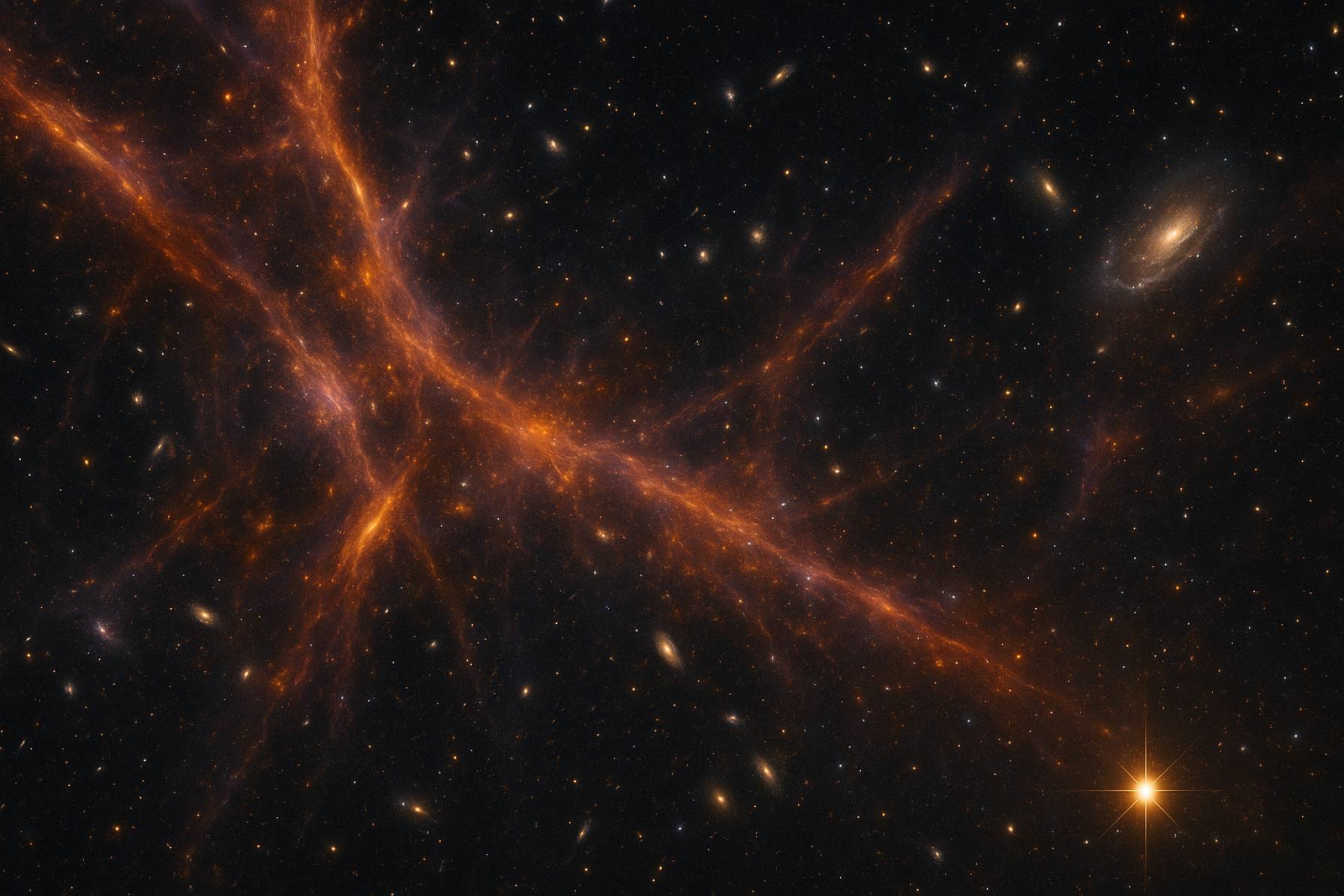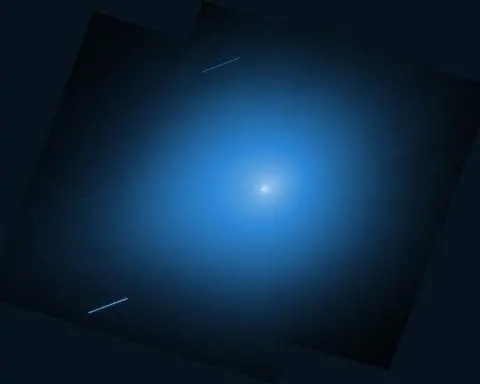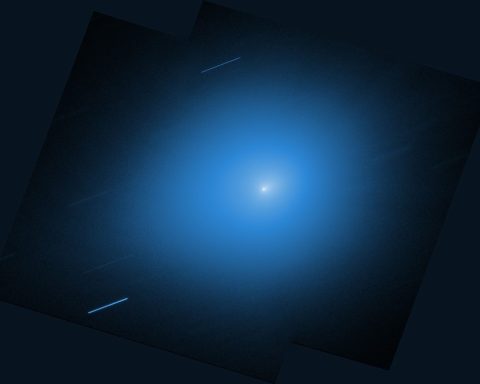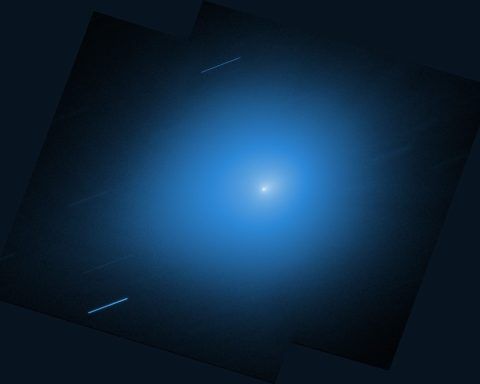- Konstantinos Migkas and team mapped a 23-million-light-year cosmic web filament with temperatures around 10 million degrees, more than 20 times the Milky Way’s size, detected via the Sunyaev-Zel’dovich effect and Planck data.
- Durham University simulations predict 80–100 undetected Milky Way satellite galaxies, the so‑called orphan galaxies stripped of dark matter halos, potentially solving the missing satellites problem and bolstering the ΛCDM model.
- Interstellar object 3I/ATLAS, the third known interstellar visitor, is over 7 billion years old and travels at about 60 km/s, observed by Zwicky Transient Facility and confirmed by the Very Large Telescope with peak brightness expected in late October 2025.
- Mars’ Noachis Terra region contains over 15,000 kilometers of ancient river channels, supporting a warm, wet past on the planet.
- Saturn’s moon Enceladus hosts a subsurface ocean with a highly alkaline pH and hydrothermal-like chemistry, making it a prime candidate in the search for life.
- The UK‑led VERVE mission, riding with ESA’s EnVision, will search Venus’ clouds for phosphine and ammonia as potential biosignatures.
- Parker Solar Probe flew within 6.1 million kilometers of the Sun, delivering the closest images of the Sun and revealing a helicity barrier related to coronal heating.
- James Webb Space Telescope continues to peer back more than 13.5 billion years with its folding design and a large sunshield, enabling unprecedented views of early galaxies.
- Lockheed Martin proposes a fixed Mars Sample Return budget of $3 billion, far below NASA’s estimated $7 billion, to complete the mission.
- China achieved the first orbital satellite refueling between SJ-21 and SJ-25, marking a milestone in on‑orbit servicing capabilities.
The Universe’s Skeleton Revealed: Mapping the Cosmic Web
Astronomers have achieved a milestone in cosmic cartography by mapping the cosmic web—the vast, filamentary structure that connects galaxy clusters across the universe. Using X-ray observatories, Konstantinos Migkas and his team detected a staggering 23-million-light-year filament, with temperatures soaring to 10 million degrees. This filament, more than 20 times the size of the Milky Way, is a crucial piece in the puzzle of the universe’s large-scale structure and the hunt for its “missing” ordinary matter.For decades, cosmologists have theorized that the universe’s visible matter—stars, planets, gas—accounts for only a fraction of the baryonic (ordinary) matter predicted by models. The rest was presumed hidden in the hot, diffuse filaments of the cosmic web. Now, with the help of the Sunyaev-Zel’dovich effect and ESA’s Planck satellite data, astronomers have directly detected these elusive structures, confirming their role as the universe’s hidden backbone and solving a decades-old cosmic mystery. [1] | [2] | [3]Key Takeaways:- Cosmic web filaments are now directly observed, not just theorized.
- These filaments are superhot (10 million °C) and vast (23 million light-years).
- They contain much of the universe’s missing baryonic matter.
- This discovery advances our understanding of galaxy formation and cosmic evolution.
The Milky Way’s Hidden Satellites: A Galaxy Teeming with Ghosts
A series of groundbreaking supercomputer simulations by Durham University cosmologists suggest the Milky Way may host 80–100 more satellite galaxies than currently observed. These faint, “orphan” galaxies, stripped of their dark matter halos, could resolve the so-called “missing satellites problem” and bolster the Lambda Cold Dark Matter (ΛCDM) model—the prevailing theory of cosmic structure formation.Dr. Isabel Santos-Santos, lead researcher, explains, “We think there should be dozens more of these faint galaxies orbiting around the Milky Way at close distances.” The Rubin Observatory’s LSST camera, with its unprecedented sensitivity, may soon confirm these predictions, opening new avenues for dark matter research and galactic archaeology. [4] | [5] | [6] | [7] | [8] | [9]Bullet Recap:- Simulations predict 80–100 undetected Milky Way satellite galaxies.
- These “orphan” galaxies are faint, stripped of dark matter, and hard to spot.
- Their discovery would strengthen the ΛCDM model and help solve the missing satellites problem.
- Next-generation telescopes like Rubin Observatory’s LSST are key to their detection.
Interstellar Visitors: Comet 3I/ATLAS and the Solar System’s Ancient Guests
The solar system has welcomed a rare visitor: comet 3I/ATLAS, only the third known interstellar object to pass through our neighborhood. Detected by the Zwicky Transient Facility (ZTF) and confirmed by the European Southern Observatory’s Very Large Telescope, 3I/ATLAS is estimated to be over 7 billion years old—older than the Sun itself. Its hyperbolic trajectory and high velocity (nearly 60 km/s) confirm its extrasolar origin.Astronomers are eager to study its composition, structure, and origin, as interstellar comets offer a unique glimpse into the chemistry and dynamics of other star systems. The comet will peak in brightness in late October 2025, though it will remain a faint, fast-moving object best observed with large telescopes. [10] | [11] | [12] | [13] | [14] | [15]Highlights:- 3I/ATLAS is the largest and fastest interstellar object observed so far.
- Its study could reveal the primordial chemistry of other star systems.
- The comet’s passage is a rare opportunity for astronomers and skywatchers.
Mars: Rivers, Wet Climates, and the Red Planet’s Surprising Past
New research using NASA’s Mars Reconnaissance Orbiter (MRO) and high-resolution mapping has revealed over 15,000 kilometers of ancient riverbeds in Mars’ Noachis Terra region. These findings challenge the long-standing view of Mars as a cold, dry world, instead supporting theories of a long-lived wet climate—possibly with rain-fed rivers and persistent surface water.Scientists continue to debate whether Mars was “warm and wet” or experienced brief, episodic wet periods. However, the evidence for extensive river channels and water-altered minerals strengthens the case for a more Earth-like past, with implications for the planet’s habitability and the search for ancient Martian life. [16] | [17]Summary:- Mars’ Noachis Terra hides thousands of kilometers of ancient rivers.
- Evidence points to a warm, wet climate in Mars’ distant past.
- These findings inform the search for past life and future exploration.
Enceladus: Saturn’s Moon Emerges as a Top Candidate for Life
Data from the Cassini mission have revealed that Saturn’s moon Enceladus harbors a subsurface ocean with a highly alkaline pH, potentially suitable for microbial life. Chemical interactions between the ocean and the moon’s rocky core create conditions similar to Earth’s hydrothermal vents—prime habitats for extremophiles.Planetary scientist Christopher Glein notes, “Chemical processes between water and the moon’s rocky core create conditions similar to Earth’s hydrothermal vents.” Enceladus is now considered one of the most promising places in the solar system to search for extraterrestrial life. [18]Venus: The VERVE Mission and the Hunt for Life in the Clouds
The UK-led VERVE mission aims to answer one of planetary science’s most tantalizing questions: Are the clouds of Venus home to microbial life? The CubeSat probe, hitching a ride with ESA’s EnVision mission, will search for phosphine and ammonia—gases considered potential biosignatures.“There are no known chemical processes for the production of either ammonia or phosphine, so the only way to know for sure…is to go there,” says Professor Jane Greaves. If VERVE detects these gases in significant quantities, it could revolutionize our understanding of life’s potential beyond Earth. [19] | [20]The Sun Up Close: Parker Solar Probe’s Record-Breaking Flyby
NASA’s Parker Solar Probe has set a new record, flying just 6.1 million kilometers from the Sun and capturing the closest images ever of our star. The probe’s WISPR instrument has provided unprecedented views of the solar wind and the corona, offering vital data on the origins of space weather that can affect Earth.The probe also discovered a ‘helicity barrier’ in the Sun’s 2-million-Kelvin corona, potentially solving the coronal heating problem by linking turbulence and magnetic wave theories. [21] | [22] | [23]Space Weather Alert: Sunspot AR4136 and the Threat to Satellites
A massive sunspot, AR4136, is erupting with Ellerman bombs—magnetic explosions that could trigger M-class solar flares. As the sunspot rotates toward Earth, scientists warn of potential radio blackouts and satellite malfunctions. Space weather monitoring is critical, as solar activity can disrupt navigation, communications, and even power grids. [24]Starlink, Satellite Internet, and the Global Connectivity Race
SpaceX’s Starlink: Ambition Meets Reality
SpaceX’s Starlink project, now valued at $400 billion, aims to provide global satellite internet via a constellation of over 12,000 satellites (with 7,600 already in orbit). While Starlink has regulatory approval and is being tested on Czech trains for high-speed passenger Wi-Fi, the project faces significant technical, financial, and logistical hurdles. [25] | [26] | [27]Japan and EU: Building a Satellite Network to Rival SpaceX
Japan and the European Union are collaborating to develop a joint satellite network, aiming to reduce reliance on US companies like SpaceX and accelerate global high-speed internet coverage. The partnership involves technology sharing, joint investment, and the launch of small satellites. [28] | [29]China’s Direct-to-Satellite Revolution
China Telecom has launched direct-to-satellite applications, enabling mobile phones to make satellite calls and send messages without changing SIM cards. This technology ensures critical communication in remote or disaster-prone areas and is part of China’s broader push for satellite communication integration. [30]Russia’s ‘Starlink Killer’ Falls Short
Russia has unveiled the ‘Breeze’ maritime drone with the RS-30M satellite terminal as a national alternative to Starlink. However, analysts note it relies on outdated geostationary satellite technology, resulting in high latency and low bandwidth—making it unsuitable for modern military or commercial applications. [31]Satellite Technology: Innovations and Challenges
China’s Breakthrough in Orbital Satellite Refueling
China has achieved the world’s first orbital refueling between satellites (SJ-21 and SJ-25), a maneuver that could extend satellite lifespans, reduce space debris, and reshape global space strategies. If confirmed, this capability marks a significant leap in space operations. [32]Landspace’s Zhuque-3: China’s Reusable Methane Rocket
Chinese firm Landspace plans to debut its reusable methane-fueled Zhuque-3 rocket in late 2025, aiming to rival SpaceX’s Falcon 9 in payload capacity and serve China’s satellite megaconstellations. [33]Satellite SOS: Lifeline in Remote Areas
With advances in satellite technology, some smartphones (like iPhone 14+) can now send emergency messages via satellite when cellular networks fail. However, not all devices support this feature, so preparedness is essential for those venturing into remote regions. [34]Shared Satellite Models: Lowering the Barriers
Startups SpaceLocker and Skynopy are partnering to launch a shared satellite mission in 2026, offering modular satellite hosting and ground connectivity to lower costs and increase accessibility for satellite operations. [35]U.S. Space Policy in Turmoil: Budget Cuts, Leadership Changes, and Uncertain Future
Trump Administration’s NASA Cuts: A Threat to U.S. Space Leadership
Proposed budget cuts to NASA’s Earth Science Division would cancel crucial Earth-observing satellites, undermine U.S. scientific leadership, and jeopardize future space missions. Experts warn of long-term damage to America’s space capabilities and the potential closure of NASA research centers. [36]Former NASA Administrator Sounds the Alarm
Dan Weedman, former NASA administrator, warns that the 2025 budget bill poses an “existential threat” to planetary science, astrophysics, and educational outreach, jeopardizing missions like Chandra and Spitzer. [37]Leadership Shakeup: Sean Duffy Appointed Interim NASA Chief
President Trump has appointed Sean Duffy, a former congressman and reality TV star with little space policy experience, as interim NASA administrator. The move follows the withdrawal of tech billionaire Jared Isaacman and has sparked concerns about leadership and expertise, especially as over 2,000 high-ranking NASA employees reportedly plan to leave the agency. [38] | [39]NOAA’s Weather Satellites: Upgrades and Budget Threats
NOAA is activating GOES-19 as the new “GOES East” satellite, providing critical weather and environmental hazard coverage from New Zealand to Africa. GOES-16 will move to backup status, ensuring robust monitoring of global weather patterns. [40]However, the proposed 2026 NOAA budget eliminates the Traffic Coordination System for Space (TraCCS), designed to prevent satellite collisions. Experts warn this could set the U.S. back by decades in space traffic management, increasing the risk of catastrophic orbital debris events. [41]NASA’s Earth Observation and Open Data Initiatives
NASA is enhancing the usability of satellite Earth observation data for U.S. federal agencies through the Satellite Needs Working Group (SNWG). This initiative supports decision-making in disaster response, weather prediction, and resource monitoring, leveraging advances in remote sensing and open data policies. [42] | [43]The James Webb Space Telescope: Peering Back in Time
The James Webb Space Telescope (JWST) continues to revolutionize astronomy with its folding design, SPF 1 million sunshield, and ability to peer over 13.5 billion years into the universe’s history. JWST is revealing the first galaxies after the Big Bang and providing unprecedented insights into cosmic evolution. [44]Mars Sample Return: Lockheed Martin’s Rescue Plan
With NASA’s Mars Sample Return mission facing cancellation due to budget cuts, Lockheed Martin has proposed a fixed budget plan to complete the mission for $3 billion—less than half of NASA’s $7 billion estimate. By leveraging existing vehicles and services, Lockheed aims to keep Mars exploration on track. [45]Zombie Satellites: Relay 2’s Mysterious Signal
Astronomers were baffled when the long-inactive Relay 2 satellite, launched in 1964 and decommissioned in 1967, emitted a strong radio signal. Initially mistaken for an astronomical event, the signal was traced to the satellite, raising concerns about space debris and the unpredictable behavior of “zombie” satellites. [46] | [47]Astronomy for All: Buck Moon, Northern Lights, and Space Education
July’s Full Buck Moon: Illusions and Planetary Highlights
July’s full buck moon peaks this week, appearing unusually low and orange due to atmospheric scattering and the “moon illusion.” The event coincides with the 60th anniversary of NASA’s Mariner 4 Mars flyby—the first photos of another planet from space. [48] | [49] | [50]Northern Lights Alert
Skywatchers in the northern U.S. can catch the northern lights tonight, thanks to a moderate Kp index and favorable conditions. [51]Space Education: Mission Cosmic Campout
The U.S. Space and Rocket Center’s “Mission: Cosmic Campout” offers children a unique, space-themed overnight adventure for their stuffed animals, fostering imagination and interest in space exploration. [52]International Space Station: Axiom-4’s Multinational Crew
The Axiom-4 mission crew, including Indian astronaut Shubhanshu Shukla, exemplified international camaraderie aboard the ISS, sharing meals and conducting microgravity experiments. The mission highlights the collaborative spirit of space exploration. [53]Outlook: The Next Frontiers
What’s Next in Space Science and Policy?
- Cosmic web mapping and the hunt for hidden galaxies will reshape our understanding of cosmic structure and dark matter.
- Interstellar objects like 3I/ATLAS offer rare windows into the chemistry of other star systems.
- Mars and Enceladus remain prime targets in the search for past and present extraterrestrial life.
- Satellite technology is advancing rapidly, but policy and budget uncertainties threaten U.S. leadership and global cooperation.
- SpaceX’s Starlink and international satellite networks will continue to battle for global connectivity dominance.
- Space weather and orbital debris management are more critical than ever as our reliance on satellites grows.
Final Thoughts
This week’s space news underscores a universe in flux—scientifically, technologically, and politically. From the cosmic web’s hidden filaments to the political turbulence threatening NASA’s future, the cosmos is as dynamic as ever. As new discoveries challenge our understanding and new technologies reshape our capabilities, one thing is clear: the next decade will be transformative for humanity’s place in the universe.Stay tuned for more updates and in-depth analysis from the frontiers of space.
Sources:
- [54]
- [55]
- [56]
- [57]
- [58]
- [59]
- [60]
- [61]
- [62]
- [63]
- [64]
- [65]
- [66]
- [67]
- [68]
- [69]
- [70]
- [71]
- [72]
- [73]
- [74]
- [75]
- [76]
- [77]
- [78]
- [79]
- [80]
- [81]
- [82]
- [83]
- [84]
Article compiled and edited by your senior aerospace editor. For the most comprehensive, up-to-date space news, stay with us.
Complete List of Reference Sources
References
1. skyandtelescope.org, 2. www.ecoticias.com, 3. www.eldiario24.com, 4. thedebrief.org, 5. www.abc.es, 6. www.bbc.com, 7. nautil.us, 8. science.mail.ru, 9. www.ras.ac.uk, 10. www.caltech.edu, 11. www.space.com, 12. www.universetoday.com, 13. scitechdaily.com, 14. www.theweathernetwork.com, 15. www.economist.com, 16. www.universetoday.com, 17. scitechdaily.com, 18. tsn.ua, 19. ras.ac.uk, 20. thedebrief.org, 21. www.universetoday.com, 22. www.kcra.com, 23. www.iflscience.com, 24. dailygalaxy.com, 25. www.forbes.ru, 26. 247wallst.com, 27. www.economica.net, 28. www.donews.com, 29. asia.nikkei.com, 30. finance.sina.cn, 31. united24media.com, 32. orbitaltoday.com, 33. www.space.com, 34. www.giornaledibrescia.it, 35. techacute.com, 36. www.404media.co, 37. www.wsws.org, 38. www.al.com, 39. www.masslive.com, 40. www.nesdis.noaa.gov, 41. skyandtelescope.org, 42. www.earthdata.nasa.gov, 43. www.earthdata.nasa.gov, 44. science.nasa.gov, 45. bgr.com, 46. cnnportugal.iol.pt, 47. www.merkur.de, 48. www.cnn.com, 49. www.freep.com, 50. www.manchestereveningnews.co.uk, 51. dailygalaxy.com, 52. www.rocketcitynow.com, 53. www.tribuneindia.com, 54. skyandtelescope.org, 55. www.ecoticias.com, 56. www.eldiario24.com, 57. thedebrief.org, 58. www.abc.es, 59. www.space.com, 60. www.universetoday.com, 61. scitechdaily.com, 62. tsn.ua, 63. ras.ac.uk, 64. www.universetoday.com, 65. dailygalaxy.com, 66. 247wallst.com, 67. www.donews.com, 68. finance.sina.cn, 69. united24media.com, 70. orbitaltoday.com, 71. www.space.com, 72. www.404media.co, 73. www.wsws.org, 74. www.al.com, 75. www.nesdis.noaa.gov, 76. skyandtelescope.org, 77. www.earthdata.nasa.gov, 78. science.nasa.gov, 79. bgr.com, 80. www.merkur.de, 81. www.cnn.com, 82. dailygalaxy.com, 83. www.rocketcitynow.com, 84. www.tribuneindia.com










